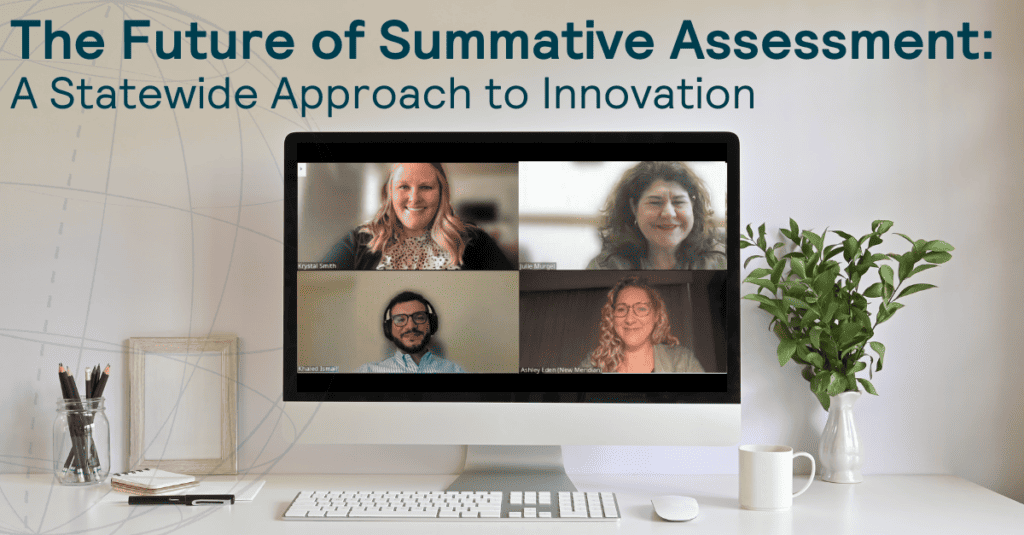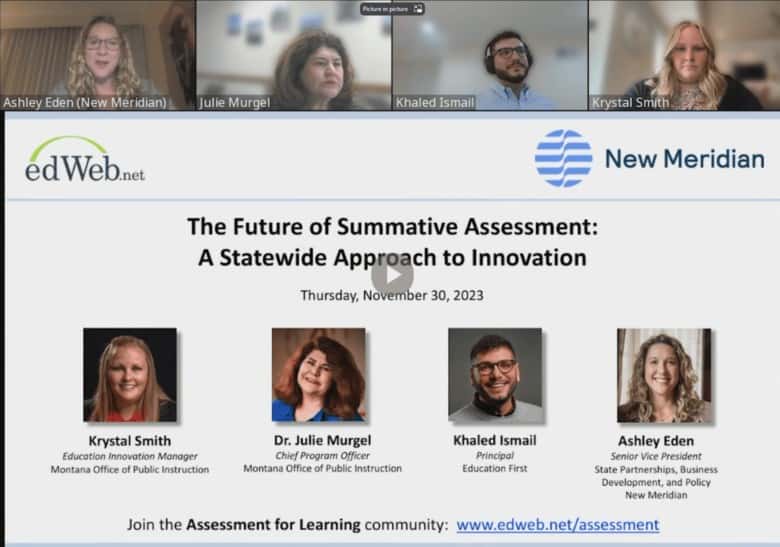
Three Common Questions on Through-Year Assessment
Few topics raise more questions among educators than through-year assessment. With a dozen states piloting or operating through-year models—all of them different—teachers and administrators are curious about the impact these programs can have in the classroom and beyond.
Many of those questions were aired at New Meridian’s latest webinar, “The Future of Summative Assessment: A Statewide Approach to Innovation,” which drew hundreds of participants from around the country. The expert panel consisted of Khaled Ismail, principal at Education First, a national strategy and policy organization; Dr. Julie Murgel, the chief program officer at the Montana Office of Public Instruction; and Krystal Smith, the education innovation manager, also from the Montana Office of Public Instruction. Led by New Meridian’s Ashley Eden, who moderated the panel, the experts answered many common questions.
Much of the discussion centered on the pilot program in Montana, which administers a series of short exams, or “testlets,” throughout the year that are aligned to local math and English curricula. This gives teachers timely feedback on student performance and the ability to adjust. Those tests can then be combined to form a year-end summative score, giving administrators the data they need.
More than 20,000 students have participated in the through-year model, and the state obtained a federal waiver from the U.S. Department of Education to eliminate duplicative testing. Montana now plans to take the program statewide in the 2024-2025 school year.
Here are some of the most common questions asked and answered at the webinar:
How has Montana’s through-year program impacted teachers?
Smith said that gauging the impact in Montana was closely tied to collecting input from stakeholders because the effect on teachers can change and improve as the system is refined each year.
“You have to have those key components of feedback built into the model … in order for it to be successful,” she said. “So we intentionally built in several feedback cycles, from early on in the first year of the pilot into the second year of the pilot. After every testing window, we provide a feedback session where we have district leaders, teachers, special ed directors, and IT directors, because we know it really takes all these people and their expertise in order to pull off a statewide assessment.”
Smith said teachers and other stakeholders gave valuable input on all aspects of the testing system, from the number of testing windows and the length of the tests to how the assessments are aligned to the curriculum.
“We want folks to be engaged in this, we want to hear what they have to say, because we want to be flexible and adapt to their needs,” she said. “We are constantly receiving feedback from our stakeholders … and we continue to look to implement what they’re asking for.”
Does through-year testing only work for a specific curriculum, or can they accommodate multiple curricula?
Murgel said that, in Montana, the through-year system does not depend on using a particular curriculum. Rather, it depends more on which state standards are being taught and when. Teachers are asked to spell out when they will be addressing specific standards in math and English and that information is used to create curriculum-aligned tests.
“There is a high level of flexibility for districts to determine which standards will be tested and when,” she said.
The state has started to spot patterns and variances that relate to when math and English standards are taught across grade levels. “We’re seeing some need to have further conversation about what makes sense and how you actually individualize curriculum for students across the year,” she said. “I think that we’ve learned a lot about that particular question.”
Eden said that Louisiana, where New Meridian’s through-year program is being piloted in math, they have taken a different approach from Montana. While Montana’s program is expanding to be state-wide next year, the Louisiana pilot is smaller and more focused.
“In Louisiana, they have put significant effort into getting districts and schools to adopt high-quality curriculum,” Eden said. “If you test throughout the year, it’s a nice way to ensure fidelity to the curriculum.”
Why are through-year models getting so much attention nationwide?
Experts said that much of the current focus on through-year assessment was born out of the pandemic, which closed schools, halted testing and threw learning into tumult in many communities. The situation created a natural window in which to examine state assessment systems.
“I think the pandemic really highlighted for a lot of folks the need for time-relevant information that can be actionable throughout the year, and that can inform instruction and intervention,” Ismail said. “There is appeal to a model where you can have both information that could be used for policy making, and for resource allocation for accountability purposes.”
While there are many ways for teachers to get a handle on student performance in real time, Ismail said there is value in an assessment system that gives both teachers and administrators actionable data without heavy lifting.
“Educators are really smart,” he said. “I have no doubt that teachers figure it out on a day-to-day basis. But if we can make their lives a little bit easier, streamline the information that they’re getting, connect it to what they’re doing throughout the year, and then help them see at the end of the year how they’ve made progress on student learning, that is appealing.”
The work in Montana and Louisiana has given rise to New Meridian’s MasteryGuide Assessment for states and ProgressGuide Assessment for districts. Ismail said the model can inform assessment systems nationwide.
“We saw the potential … not only to be able to address some of the needs and concerns that are relevant to Montana, but to the country as a whole,” he said.
Want to learn more about New Meridian’s through-year assessments? Talk to one of our experts.



